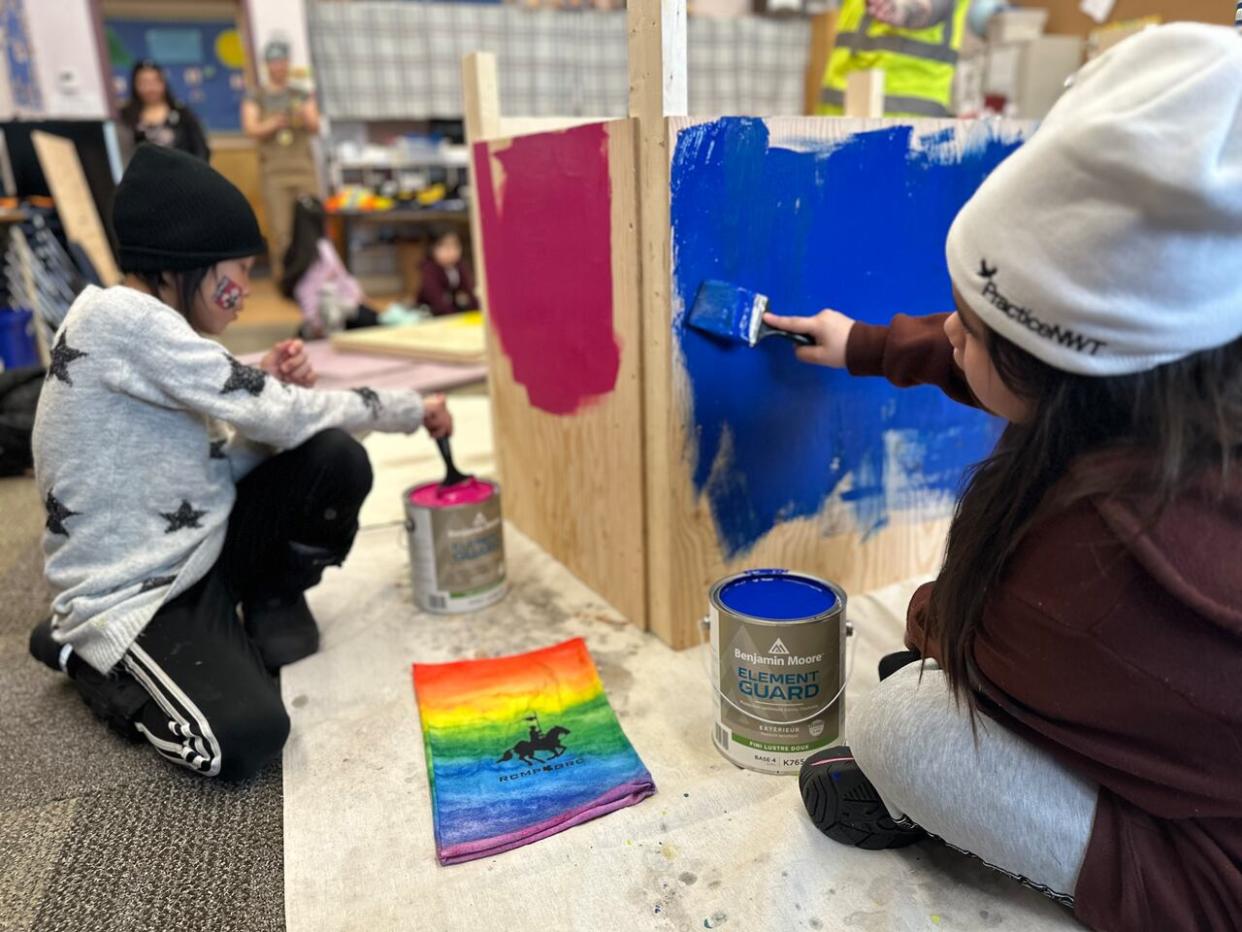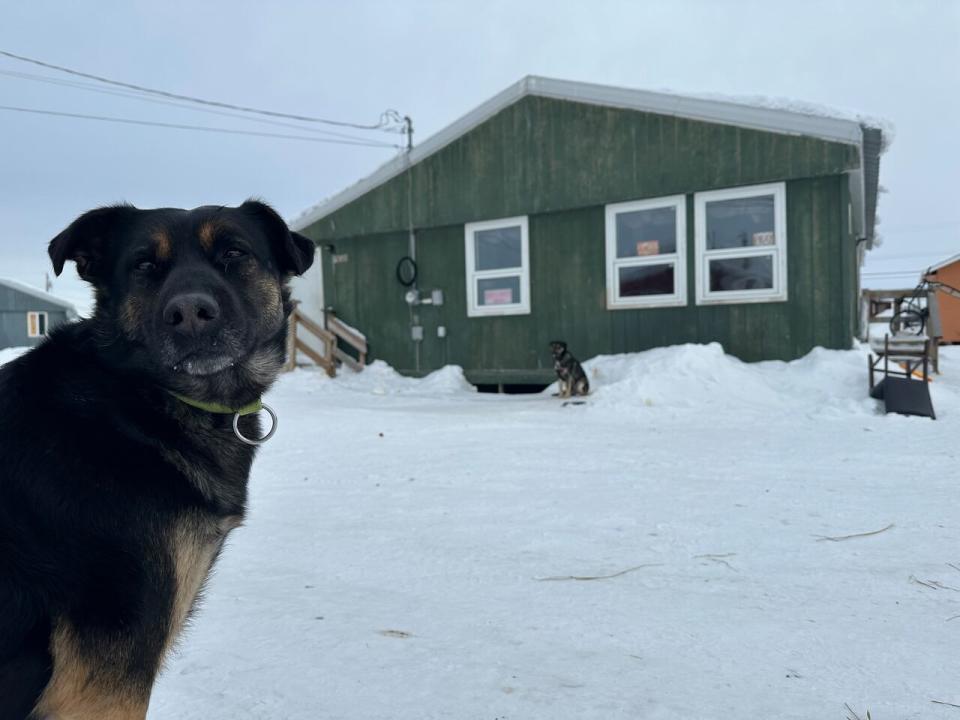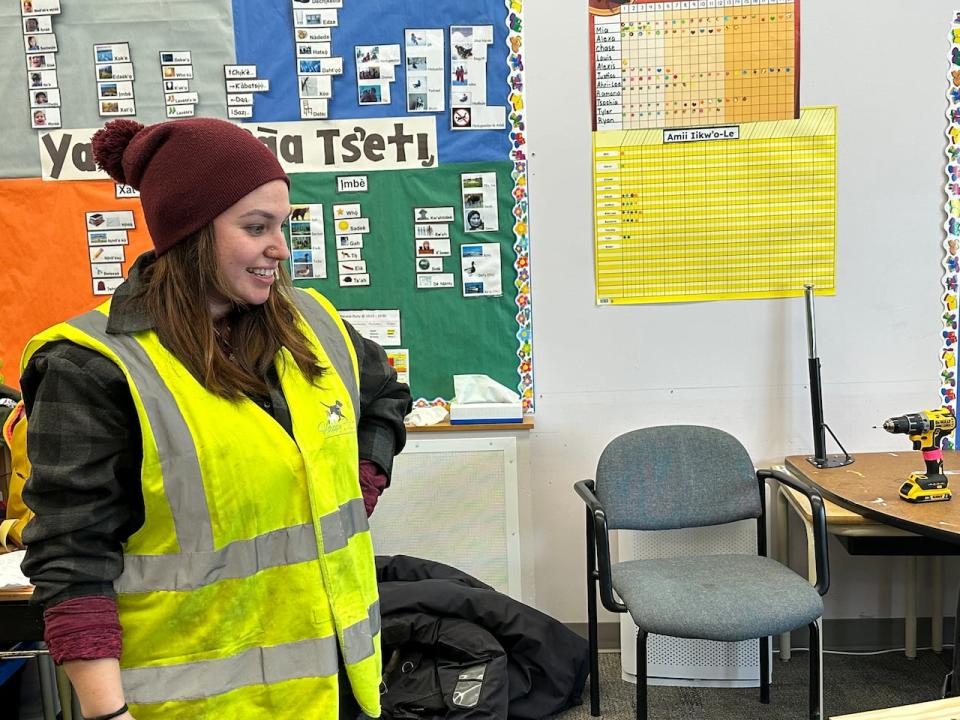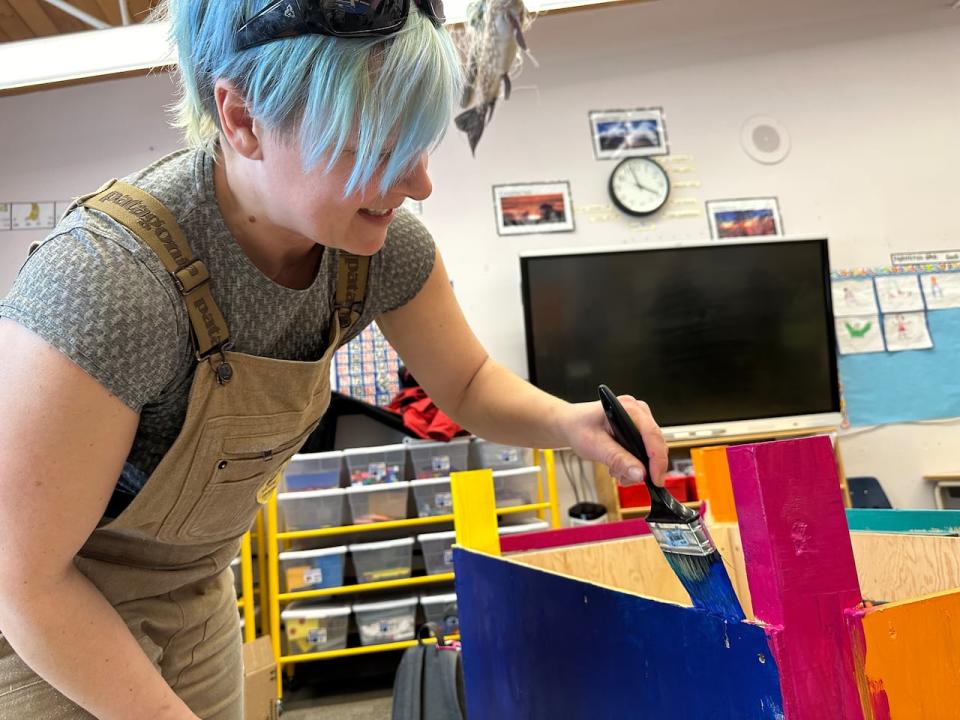Behchokǫ̀ kids build homes for four-legged friends

Bear, a dog N.W.T. residents would describe as a "northern special" in Behchokǫ̀, is getting a dog house that matches his bark — loud.
The house's insulated walls are painted blue, pink, teal and orange. The legs that lift it off the ground, to keep snow from drifting in, are all different colours too. The removable roof is a bright, sunny yellow.
"You can tell there was kids involved, and they put a lot of love into it," observed Dana Mackenzie, one of the founding members of the Tłı̨chǫ Animal Care Society. "It's beautiful. Never seen anything so beautiful all day."
Bear's new shelter was the end result of a dog house-making workshop at the Learning Together Gathering in Behchokǫ last week. The workshop was spearheaded by Tiarella Hanna, another one of the society's founding members.

A pair of dogs outside a home in Behchokǫ̀, N.W.T. on Thursday, March 14. The dog in the foreground is named Connie. The dog in the background, Bear, was expected to receive a dog house built at a workshop in the community last week. (Liny Lamberink/CBC)
Hanna said through her business, she received $10,000 from the Tłı̨chǫ Government to build dog houses in Behchokǫ and Edzo. Funding had also been secured to send 10 dog house building kits to Whatì, she said, and she was hoping to get funding for kits for Gamètì as well.
The houses are being given to Tłı̨chǫ residents free of charge. It's just one of the ways Hanna and the society are trying to improve the lives of loose dogs living in Tłı̨chǫ communities.
"A lot of the dogs now don't have the fur coats that they had back in the day," explained Hanna.
"They're no longer purebred Huskies or Inuit sled dogs. They're mixed with pit bulls and shepherds and labs. So there's a lot of dogs who won't have the coats to be able to survive outside on their own and live a healthy life."

Dana Mackenzie oversees some of the work happening at the dog house-making workshop. (Liny Lamberink/CBC)
What to do with too many dogs
The Tłı̨chǫ Animal Care Society — which Mackenzie said officially became a society last Tuesday — was born out of a big undertaking to remove dogs from Behchokǫ during last summer's wildfires.
Mackenzie said about 80 of the 200 animals that were rescued from the community weren't claimed again, and people had suggested not bringing them back because of the "huge overpopulation problem."
"Our dogs have kind of not been used as much as they have been in the past. We needed them to travel and for hunting, and when people started getting snowmobiles and vehicles — it's like they don't have a job anymore," she said. "People don't really know what to do with them."

A dog house on display at Elizabeth Mackenzie School in Behchokǫ̀, with its removable lid taken off. Tiarella Hanna, who spearheaded the dog house making workshop there last week, said she spent more than 70 hours working on an optimal design. (Liny Lamberink/CBC)
In an effort to address the overpopulation challenge, the society is working toward a number of goals.
Hanna said they want to host spay and neuter clinics in each community once a year, arrange for vaccinations, and help the community government establish a paid position that enforces dog-related bylaws.
Mackenzie said she's also been advocating for space to build an animal shelter in Behchokǫ.
"But mostly, the focus is trying to get more people on board with them being part of the solution, taking proper care to keep their dogs at home, and making sure they're not making too many puppies," said Mackenzie.
The perfect dog house
The design for the dog houses — including Bear's — is something Hanna said she's laboured over for more than 70 hours.
"This is the extra large version of the dog house," she said, standing beside a teal-coloured model on display at the Elizabeth Mackenzie Elementary School in Behchokǫ.

Tiarella Hanna, a founder of the Tlicho Animal Care Society, does some touch ups after a handful of kids have finished painting the dog house. (Liny Lamberink/CBC)
The house is built on legs so the front opening is about one foot off the ground, to prevent it from rotting and to give it some distance from the snow that'll pack the ground around it. The entrance also has a lip around it, to keep snow from coming in and to keep straw bedding from being pushed out.
"We've got insulated walls. There's [an] inch and a half foam in between half-inch plywood and quarter-inch plywood," said Hanna. The removable lid also makes it easier to access a dog, such as a mother and puppies, if needed.
"Maybe I'm not the most efficient builder, but yeah, I'm happy with the end result," said Hanna.
Bear's owner, an 11-year-old named Maggie Drybones, said she was happy as well.

Maggie Drybones, left, sinks a screw into one of the dog house walls under the watchful eye of Alex Lafferty. (Liny Lamberink/CBC)
People signed a sheet in the classroom during the workshop saying they, too, were interested in receiving a dog house. But the handful of children who were kept busy building throughout the afternoon were all in agreement — Bear would get the house they were working on together.
Drybones said she hopes it keeps him warm during the cold winters and safe from wolves.
"He might love the dog house," she said. "He might probably go inside it and sleep."

